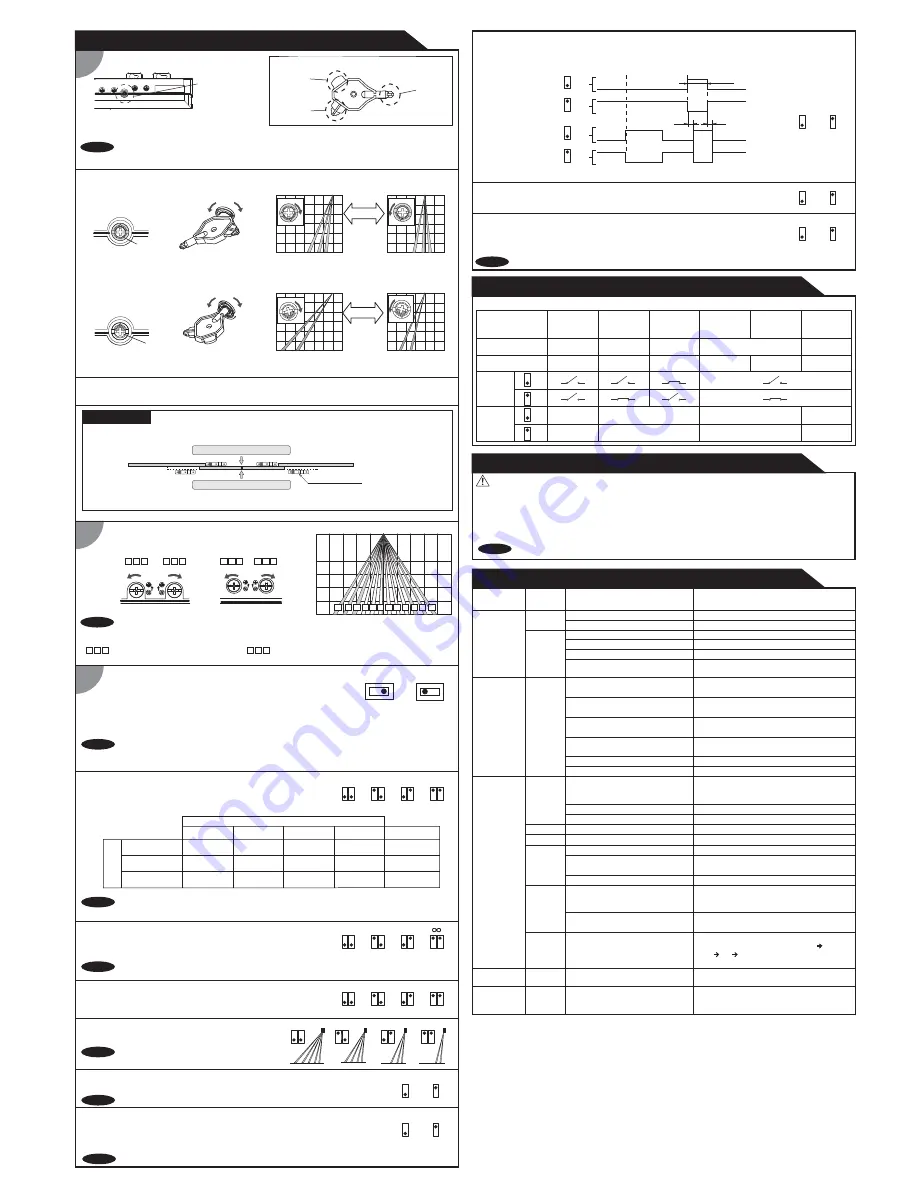
Mounting height [ m (feet,inch) ]
2.0 (6' 6")
2.2 (7' 2")
2.5 (8' 2")
3.0 (9' 10")
2
1
ADJUSTMENTS
When using more than two sensors close to each other, set the different
frequency for each sensor by dipswitches 5 and 6.
3-3.Setting the frequency
3-5.Setting the immunity
Red
4th and 5th rows
Area depth angle adjustment
1st to 3rd rows
C
Area adjustment tool
A
B
Area width adjustment
Blue
Use the area adjustment tool
(B)
as shown above to
change the area depth angle for the 4th and 5th rows.
Depth angle adjustment screw
for the 1st to 3rd rows
Depth angle adjustment screw
for the 4th and 5th rows
Use the area adjustment tool
(A)
as shown above to
change the area depth angle for the 1st to 3rd rows.
1-2.Simultaneous adjustment
1-1.Independent adjustment
For the simultaneous adjustment of the 1st to 5th rows, use the adjustment tool
(C)
.
When adjusting the width adjustment screws, make sure to turn until it clicks otherwise the proper operation may not
be obtained.
cannot be eliminated separately, neither can .
Depth angle
adjustment screw
Shallow
Deep
4th and 5th rows
1st to 3rd rows
Width adjustment
screws (Right)
Width adjustment
screws (Left)
Dipswitch settings
Refer to the chart below for the suitable sensitivity to your installation environment.
3-1.Setting the sensitivity
3-2.Setting the presence detection timer
The 1st and 2nd rows have the presence detection function.
To comply with EN 16005, set the timer to " 30sec." or more.
To enable the presence detection, do not enter the detection area for 10 seconds after setting the timer.
When adjusting the 1st row close to the door,
follow
3-9 Installation mode
for the easier adjustment.
Special attention to the setting is required when the door is used often by the elderly or children.
Please adjust the sensitivity and the presence detection timer according to your risk assessment.
For example
Floor condition
Low reflection
Middle
Middle
High
S-High
-Carpet
-Dark color floor
Middle reflection
Low
Middle
Middle
-Concrete
High reflection
Low
Low
Middle
High
-Tile
-Marble
S-High
When the above procedures (1-3) are not followed, an error (Red & Green blinking) occurs.
Make sure to use the sensor only in the" Operation mode".
The sensor does not operate properly in the "Setting mode".
Follow these steps to change the settings of dipswitches.
1.Change the function key from the "Operation mode" to the "Setting mode".
During the "Setting mode", the operation indicator is blinking Blue
(only when stand-by status) and the door remains open.
2.Change the dipswitch settings.
3.When the setting is finished, change the function key back to the "Operation mode".
Function key
Operation mode
Setting mode
Set the depth rows with dipswitches 7 and 8.
3-4.Setting the row adjustment
When "2rows" are selected, the activation output
is disabled.
Make sure that the detection area does not overlap with the door / header, and there is no highly reflecting
object near the detection area otherwise ghosting / signal saturation may occur.
NOTE
NOTE
NOTE
NOTE
NOTE
NOTE
INFRARED FINDER
Detection area
Detection area
1. Turn the depth angle adjustment screw to the right (Deep) to place the detection area most away from the door.
2. Set INFRARED FINDER sensitivity to "H" (High) and place it on the floor as shown below.
Area depth adjustment with INFRARED FINDER (Separately available)
REFERENCE
3. Turn the depth angle adjustment screw to the left (Shallow) until the emitting area is placed at the position where
INFRARED FINDER is in the low detection status (Slow Red blinking).
Set dipswitch 9 to ON when the sensor operates by itself (Ghosting).
3
9
9
ON
OFF
6
5
Setting1
6
5
Setting2
6
5
Setting3
6
5
Setting4
2
1
Low
2
1
Middle
2
1
High
2
1
S-High
4
3
30sec.
4
3
60sec.
4
3
180sec.
4
3
8
7
5rows
8
7
4rows
8
7
3rows
8
7
2rows
NOTE
When dipswitch 9 is set to ON ,the actual detection area may become smaller.
Shallow
Deep
Shallow
Deep
[m]
0
1.0
2.0
3.0
2.0
3.0
[m]
1.0
0
1.0
2.0
2.0
3.0
1.0
0
1.0
2.0
Shallow
Deep
[m]
[m]
2.0
3.0
0
1.0
2.0
3.0
2.0
3.0
Front view
[m]
0
2.0
3.0
0
2.0
1.0
2.0
1.0
1
2
3
4
5
6
7
8
9
10 11 12
Narrow
Wide
Eliminated
Eliminated
Eliminated
Eliminated
Narrow
Wide
Eliminated
Eliminated Eliminated
Eliminated
1
2
3
10 11 12
1
2
3
10 11 12
1
2
3
10 11 12
3-6.Setting the self monitoring
10
10
Disable
Enable
When the door remains open and the LED indicator shows fast or slow green
blinking, please refer to the
TROUBLESHOOTING
.
If the door still remains open, set dipswitch 10 to "Disable".
To comply with EN 16005 dipswitch 10 must be set to "Enable".
NOTE
Contact your installer or service engineer.
Sensor failure
Wrong wiring or connection failure
Check the wires and connector.
Wrong wiring or connection failure
Check the wires and connector.
Door operation Operation
indicator
Possible cause
Possible countermeasures
None
Wrong power supply voltage
Set to the stated voltage.
Wrong wiring or connection failure
Fast
Green
blinking
Signal saturation (1st or 2nd row)
Dirty detection window
Wipe the detection window with a damp cloth.
(Do not use any cleaner or solvent.)
Sensitivity is too low.
Set the sensitivity higher.(*)
The detection area overlaps with
the door / header.
Adjust the detection area to "Deep" (Outside).
Door opens
when no one
is in the
detection area.
(Ghosting)
Unstable
Door remains
open
Sudden change in the detection area.
Check
ADJUSTMENTS
3-1 & 3-2
.(*)
If the problem still persists, hard-reset the
sensor.(Turn the power OFF and ON again.)
Slow
Green
blinking
Check the wires and connector.
Remove highly reflecting objects from the
detection area. Or lower the sensitivity.(*)
Or change the area depth angle for 1st to 3rd rows.
Wrong setting of dipswitch
Red &
Green
blinking
Door does not
open when a
person enters
the detection
area.
Unstable
Wrong detection area positioning
Check
ADJUSTMENTS 1 , 2 & 3
.(*)
Sensitivity is too low.
Set the sensitivity higher.(*)
Short presence detection timer
Set the presence detection timer longer.(*)
Door remains
closed.
Proper
Proper
Wrong setting of dipswitches
.
Check
ADJUSTMENTS 3-6 ,3-7 & 3-8
.(*)
Dirty detection window
Wipe the detection window with a damp cloth.
(Do not use any cleaner or solvent.)
Wrong setting of function key
Set to the"Operation mode".
3-7.Setting the test input, safety / test output and test input delay time
3-9.Installation mode
Set dipswitch 16 to ON when adjusting the 1st row close to the door.
When the setting is finished, set to OFF.
During the installation mode, only the 1st row remains, and the operation indicator glows Yellow.
Check the operation in the operation mode according to the chart below.
1. Always keep the detection window clean. If dirty, wipe the window with a damp cloth.(Do not use any cleaner / solvent.)
2. Do not wash the sensor with water.
3. Do not disassemble, rebuild or repair the sensor yourself, otherwise electric shock may occur.
4. When the operation indicator blinks Green, contact your installer or service engineer.
5. Always contact your installer or service engineer when changing the settings.
6. Do not paint the detection window.
WARNING
1. When turning the power ON, always walk-test the detection area to ensure the proper operation.
2. Do not place any objects that move or emit light in the detection area. (e.g. Plant, illumination, etc.)
NOTE
3-8.Setting the activation output
Set dipswitch 14 to "N.O." (Normally Open) or "N.C." (Normally Closed) .
NOTE
If the function key is set back to the "Operation mode" while the installation mode is still ON, an error occurs.
*: The test input delay time is the time period between the test input and safety / test output.
Test input
(from door controller)
Safety / Test output
(to door controller)
High
Test input
Detection
(*)Test input delay time (=t2)
Test input and Safety / Test output timing chart
12
Low
12
High
11
Low
11
CHECKING
INFORM BUILDING OWNER / OPERATOR OF THE FOLLOWING ITEMS
14
14
N.C.
N.O.
16
16
ON
OFF
TROUBLESHOOTING
1. Set the function key to the "Setting mode".
2. Change the dipswitch 16 setting (ON OFF or
OFF ON OFF).
3. Set the function key back to "Operation mode".
Blinking Blue
Set dipswitches 11 to 13 according to the door controller.
Proper
operation
Others
Set the immunity to ON.(*)
Adjust the detection area to "Deep" (Outside).
Waterdrops on the detection window
Use the rain-cover (Separately available).
Or install in a place keeping the waterdrops off.
The detection area overlaps
with that of another sensor.
Detection area overlaps with door /
header.
Check
ADJUSTMENTS 3-3
.(*)
Objects that move or
emit light in the detection area.
Remove the objects.
Sensitivity is too high.
Set the sensitivity lower.(*)
Installation mode is set to ON
.
Set installation mode to OFF
.(*)
Yellow
t1(>t2)
t2
* Before changing these settings, set the function key to the "Setting mode". When finished, set back to the
"Operation mode".
Remove highly reflecting objects from the
detection area. Or lower the sensitivity.(*)
Or change the area depth angle.
Signal saturation (3rd, 4th or 5th row)
Slow
Green
blinking
13
13
20msec.
10msec.
Status
Green
Motion
detection active
Red
Blinking Red
Entry
Outside of
detection
area
Outside of
detection
area
Entry into
3rd to 5th row
Entry into
2nd row
Entry into
1st row
Orange
Stand-by
Green
Stand-by
Operation indicator
Motion / Presence
detection active
Power OFF
-
None
Activation
output
Safety
/ Test
output
ON
OFF
ON
OFF
OFF
ON
OFF
OFF
High
11
Low
11
N.O.
14
N.C.
14
t2
Entrematic Group AB
Lodjursgatan, 10
SE-261 22 Landskrona - SWEDEN
www.ditecentrematic.com
All manuals and user guides at all-guides.com




















